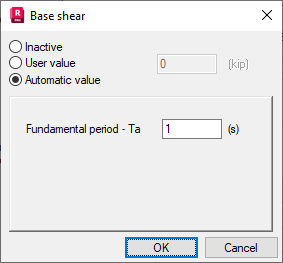- IBC 2009 (IBC 2012), IBC 2000 (IBC 2006).
- UBC 97.
- Canadian NBC 2005, NBC 2010, NBC 2015, NBC 2020.
- Indian IS: 1893 - 2002.
- Australian AS 1170.4 .
- New Zealand NZS 1170.5:2004.
- US Code ASCE 7-22.
Use this dialog to select how to take account of the base shear force: calculate it according to the provisions of the seismic code (the Automatic value option) or specify it (the User value option).
A seismic load generated in accordance with the Response Spectrum Procedure should not be greater than a load calculated using the simplified method (Equivalent Lateral Force) as a base shear force. Therefore, pseudostatic seismic forces generated in Robot are scaled so that the sum of reactions for the main seismic direction equals the base shear force.
In case of Base Shear limit is on, the values of internal forces, and reactions are scaled to obtain sum of reactions in the direction of concern equal the Base Shear. Note that the results for each mode are not scaled, but only the results of modal combinations (SRSS, CQC, 10%, 2SM) are scaled.
In case of Base Shear defined manually as User value, the results are always scaled to obtain the sum of reactions in the direction of concern equal the Base Shear, up or down, even if the Base Shear is smaller than the sum of reactions obtained in spectral analysis.
Example: calculation of the seismic base shear according to the US code IBC 2009/IBC 2012

For the seismic analysis according to the US code IBC 2009/IBC 2012, the seismic base shear V is calculated as specified in the code ASCE 7-05 Section 12.8, in two orthogonal horizontal directions using the fundamental period Ta. Internal forces are multiplied by 0.85 V / Vt, when the modal base shear Vt is less than 85 percent of the calculated base shear V using the equivalent lateral force procedure.
Using the equivalent lateral force procedure, the base shear is calculated as:
V = CSW
where:
W - effective seismic weight as in modal analysis
CS - seismic response coefficient calculated as:

The seismic response coefficient must satisfy the following condition:
0.01 ≤ CS ≤ CMAXS
where:

Additionally, for structures located where S1≥ 0.6g:

For further details concerning designations in the formulas above see: Seismic Analysis Parameters (IBC 2009/IBC 2012).
